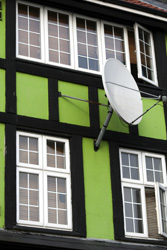New optical transmission for satellite TV and internet
Conventional broadcast TV that sends its radio wave signals via a powerful antenna to smaller ones at residences has been largely replaced by direct-broadcast satellite (DBS) TV. Satellite TV relies on the transmission and reception of signals from satellites orbiting the Earth. Currently, the signal received at the satellite dish is carried to individual viewing locations within a building via coaxial cables. The introduction of satellite receivers with multiple tuners requiring multiple cables to reach the set-top boxes (STBs) introduced a significant increase in installation cost, time and disruption, particularly in multi-dwelling units (MDUs). Fibre optic cables have been successfully used in many such cases but cost is still prohibitive for single-family homes (SFHs). The EU-funded project 'DBS LNB-STB optical fibre transmission link' (OPTOSAT) designed, built and tested a prototype demonstrator for that purpose using low-cost optoelectronic components. The system uses four separate fibre optic cables for four satellite bands to reduce costs associated with separating the signals at the receiver. The fibres are then housed within a single cable assembly. Scientists added an optical Ethernet data network for full integration of satellite TV with very high bandwidth home networking and future high-quality communication at low cost. Prototype receiver and transmitter modules were also produced, the former of which was integrated into a standard satellite receiver for an STB with optical-only input. Two separate field trials demonstrated that the system successfully delivered a full set of channels from a satellite dish to multiple locations within the home and also provided Ethernet connectivity among locations. Thus, the components conventionally used for transmission of digital signals worked admirably in the transmission of analogue satellite TV. In addition, internet protocol (IP) data connectivity can facilitate not only internet connection but also data streaming from one location to another. OPTOSAT technology for cost-effective distribution of direct video broadcasting satellite TV signals is expected to be met with widespread interest and to generate novel products not currently covered by the range of availabilities.







